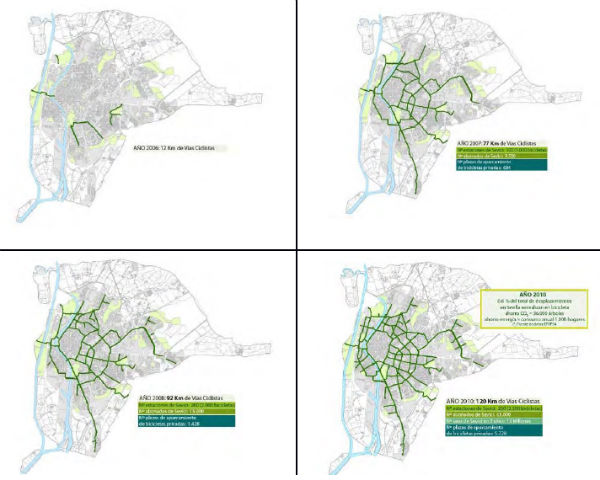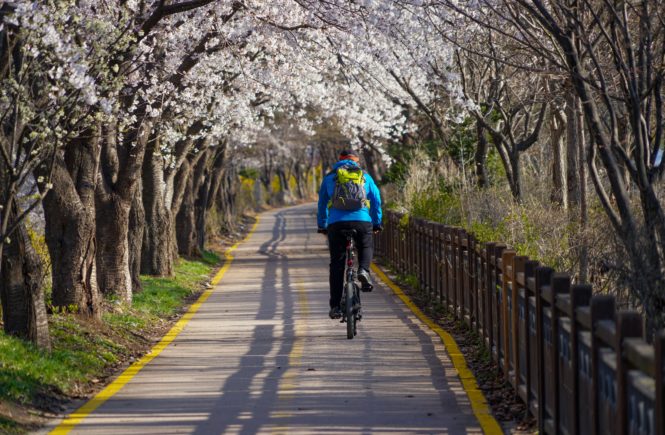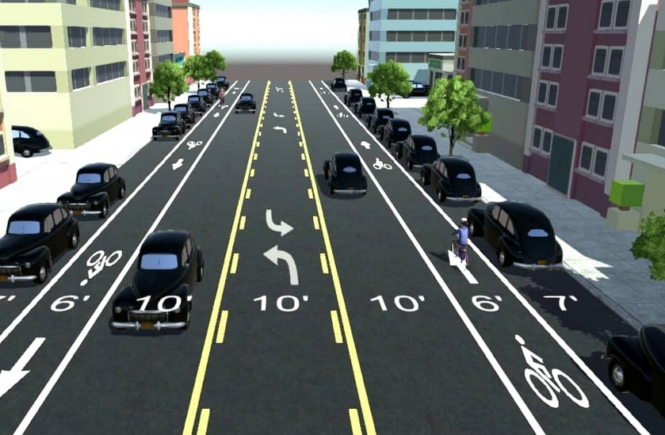I’ve helped design quite a few bike routes during my career. Some were as simple as a few traffic calming devices. Others involved fully protected bike lanes. They all had these things in common:
- They were all part of a slow, incremental buildout and part of a (very) long range bike network plan
- They all required lengthy political negotiations and community engagement processes
- They all existed as an incomplete network for years after design and construction
Don’t get me wrong – each small project which successfully constructs a facility to make cycling safer is a big accomplishment, and there’s a lot to be said for incremental buildouts during a time of constrained budgets. But even cities that have been successful in doing piecemeal bike lanes for decades still have incomplete cycling networks.
The problem with piecemeal buildouts involves both real-world usefulness, safety and perception. Bike lanes which begin and end nowhere are seldom useful to cyclists and artificially suppress ridership due to their limited connections to trip generators. Even well-planned but isolated segments which connect big trip generators like parks or mixed use districts still require cyclists to use sidewalks or auto lanes for trips outside of limited origin-destination pairs.
Now, let’s talk about safety. Even building one of the safest facilities like a curb-protected cycle track creates an inherent risk to cyclists if they’re expected to cycle on sidewalks or auto lanes to access it. Networks are only as strong as their weakest links, and an isolated cycle track not connected to any other bike infrastructure is like a single concrete column attached to a wood framed house. The entire network needs to be safe in order to accrue safety benefits of protected facilities.
The limited usefulness and safety of isolated segments suppresses ridership, and the public perception becomes, “The City is building these bike lanes for nothing – nobody is riding them.” And if the bike facility required, say, a relocation of parallel parking, a road diet, or a big political battle, the non-monetary costs of the facility begins to seem disproportional to the benefits of the project. Thus begins a negative feedback loop: Nobody is riding these bike segments, so why keep building them? Bike infrastructure gradually begins to lose public and political support.
With incremental buildouts, these non-monetary costs accrue with each phase. Each time a segment is designed, the entire network needs to be re-sold to the public, and then local politicians must continuously put their political capital behind it. If the political winds change, the network may never be completed, or shifting design priorities may create an inconsistent bike network over decades.
A useful comparison is how cities and state DOTs built road networks. Every road in your city wasn’t built at the same time, but each construction phase created a full, useful network which probably didn’t require motorists to drive through forests, sand or uncompacted dirt to get to their destination. Building bike networks in the same way isn’t too much to ask.
Maybe there’s a better way to do things. Seville, Spain built a complete bike lane network in just 4 years utilizing cycle tracks. After years of increasing traffic, the city built about 80 miles of bike infrastructure during a timeframe when most cities are lucky to build 3 or 4 miles. The effort took a combination of documented public support, political will and design expertise, but the results showed substantial ridership increases and traffic safety benefits. The key factor in the system’s success was its connectivity – a useful, complete, protected route which accessed popular destinations.

A similar story played out in Calgary. A few years ago, a full pilot network of protected lanes was built in their downtown. It became so popular that local politicians decided to make it permanent.
In the end, it seems that installing the entire network all at once worked because it offered up the big picture. It might have been easier politically to build the network one lane at a time, as most cities do, but the uptake on a lane with few connections would have been slow. In this case, dropping down a well-thought out network gave cyclists and would-be cyclists a broader peek at what a cycle-track network can do, and, more importantly, have them somewhere to go.
The network didn’t succeed because of its boldness. It succeeded because it was practical. But in the politically charged climate around cycling, boldness was needed to ensure it was functional.
So how can we apply these lessons to American cities to help build complete bike lane networks in a reasonable time frame? Here are some ideas.
- Documented public support is key, but when survey questions typically ask about bike infrastructure, they’re usually very general and don’t talk about phasing or construction timeframes. The responses for “Would you like an isolated, disconnected series of bike lanes built out over the course of 20 years” would be very different from a question asking about support for a full, quickly built network. Separating these types of questions out in community surveys can help make the case for fast, full networks.
- Frame the discussion in terms of big wins for major stakeholders. A quickly-built, well-used network will look better for everyone involved compared to an underutilized bike lane to nowhere and endless political battles.
- Construction costs almost always increase over time. Procurement, design fees and public engagement efforts for each separate phase also add up. Building full bike networks in a single phase is a great way to reduce overall system costs. Keep this in mind when advocating for projects.
- In America, State DOTs and counties often have authority over many high-capacity roads (arterials/collectors). There should be a balance between connecting to useful destinations along intuitive routes, and minimizing organizational barriers to implementation. Finding a good, but somewhat circuitous local street (which cities have more design authority over) for parts of the network may be better than going for the perfect arterial and a more direct route depending on how your State DOT views protected bike lanes.
- Seville’s bike network removed a few thousand on-street parallel parking spots. Doing the same in American cities may be more difficult. Finding alternative parking opportunities or analyzing parking demand and occupancy rates in nearby parking facilities can help make the case that excess parking capacity exists. On-street parking is a luxury, not a right.
Covid-19 and its related transportation impacts will change commuting habits and reduce automobile travel demand for the foreseeable future. There’s never been a better time to build complete bike facility networks which are a fraction of the cost of most other transportation infrastructure.
Additional research: On the effect of networks of cycle-tracks on the risk of cycling. The case of Seville. Journal of Accident Analysis & Prevention




